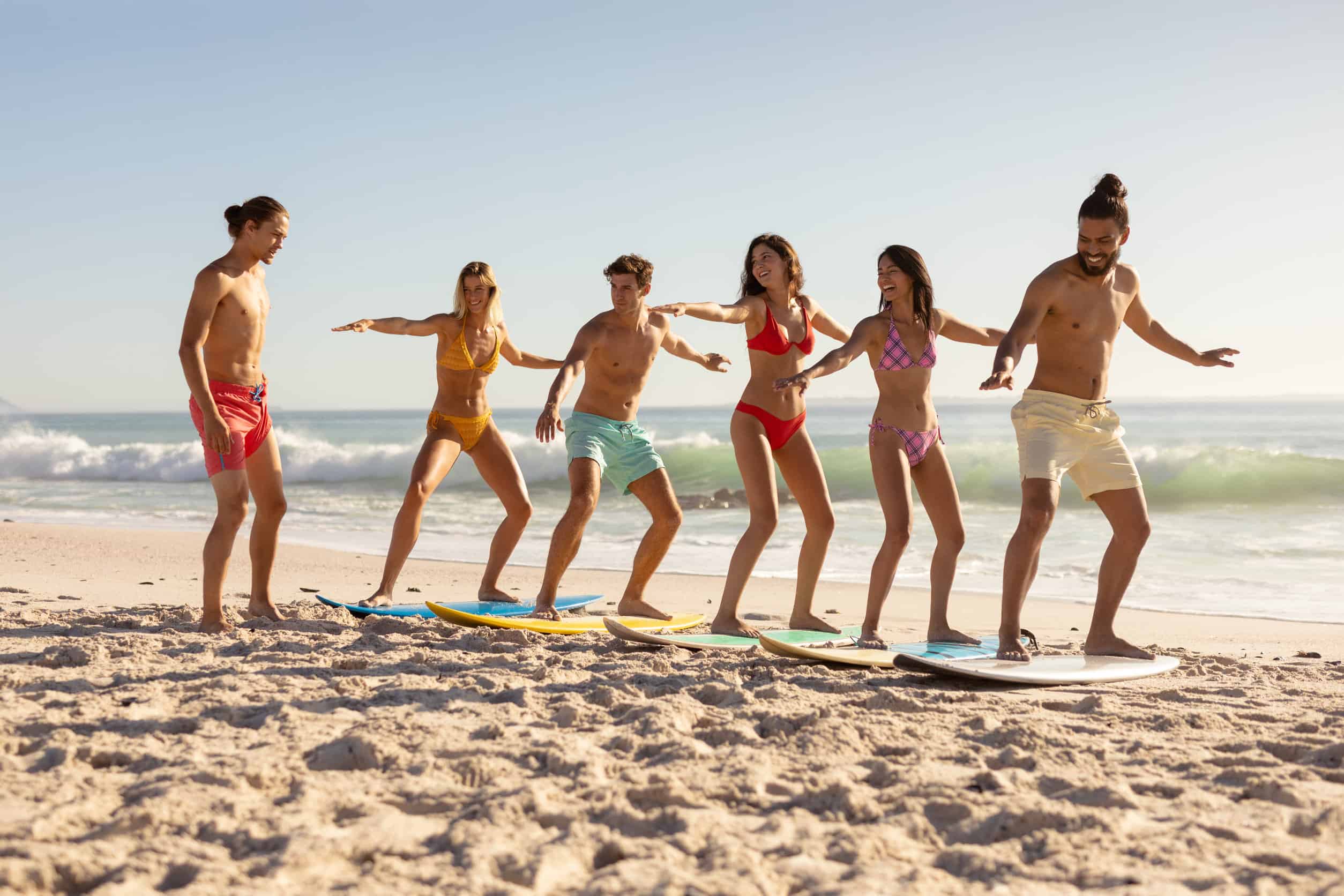You’ve decided to learn to surf, and you’re excited at the prospect of spending some time in the company of the waves. However, you have a question in your mind, “What should I wear when I go surfing for the first time?”
Women can wear a bikini or a one-piece suit, and men can wear board shorts while surfing. During winters, wetsuits are the perfect choice for both genders. But women should avoid wearing strapless swimsuits, while both genders should not wear ill-fitting wetsuits.
In the rest of this article, we’ll address this topic in more detail. We’ll discuss the kind of swimwear you should wear according to the weather and water temperature, and we’ll also talk about other gears you need as a first-time surfer, so keep reading.
Swimwear That Women Can Wear While Surfing
When it comes to swimwear, women have many options to choose from, such as a bikini, wetsuit, rash shirt, or other options. While you can choose any of them depending on your preference, knowing the pros and cons of each of them can help you make an informed decision.
Let’s take a look at some of the options.
Bikinis Are the Best Choice for Sunny Weather
When the sun is shining brightly, you may want to consider wearing a bikini or one-piece suit. It is mainly recommended during the summer because you can sunbathe when you get tired of surfing.
However, since this is your first time surfing, wearing a bikini without a strap isn’t the best option as you don’t want to flash anyone. The best option is to stick with a close-fitting bikini set.
Wetsuits Are Popular Among the Surfers
Water can get chilly at times, and staying in the water for an extended period can make you cold too. That’s where wetsuits come in, as they’re made of neoprene, which insulates your body from the cold water outside and keeps you warm.
Also, they make you look great, which is another plus.
Rash Shirts Protect You From Sun and Rashes
As a beginner, you will almost certainly fall off the board and injure yourself. And if you have to stay out in the sun for a long time, then a rash shirt with full sleeves will come in handy. It’ll save you from the sun as well as any potential rashes.
Because they’re made of spandex and nylon or polyester, they are lightweight and easy to carry while surfing.
Pair Your Swimsuit With a T-Shirt for Comfort and Ease
If you are uncomfortable surfing in a bikini, you can always wear a t-shirt over it to make yourself feel more at ease.
It’s also a great alternative to a rash shirt. If you are a beginner and do not want to invest in a rash shirt just yet, you can wear a T-shirt, which provides you with the same level of protection from the sun.
Swimwears That Men Can Wear While Surfing
As mentioned earlier, men can wear board shorts. You also have the option to wear wetsuits. You can choose one depending on your comfort and choice.
You can consider the following items as well.
Trunks Are the Right Choice for Men
Men are more likely to wear board shorts. You can pair them up with briefs, or even a wetsuit over them to keep warm for a long time. However, it is recommended that you wear trunks under your wetsuit because board shorts roll up at times, which can be an uncomfortable feeling for you.
Say Yes to the Rash Guards
When learning to surf, safety comes first. And rash guards can help you with that. Rash guards are similar to athletic long-sleeved shirts and are an excellent way to prevent surf rash. Also, they are more effective at protecting your skin than cotton.
The Best Surfing Clothes for the Cold Weather
When surfing in winter, you must opt for a wetsuit. Usually, wetsuits come in two standard sizes, 3/2 and 4/3, and you can choose one according to your need.
A 3/2 size means the wetsuit has a thickness of 3 mm (0.12 in) in some areas, usually the body, and 2 mm (0.08 in) in other places, like your legs and hands. Likewise, a 4/3 wetsuit is 4 mm (0.16 in) thick around the body but has a thickness of 3 mm (0.12 in) around arms and legs.
If the water is not too cold, you can surf in a 3/2, but if you are surfing in a colder region, a 4/3 is recommended. Usually, 3/2s are an excellent option for temperature between 62°F to 75°F (16.6°C to 23.8°C) and 4/3s are great for 52°F to 62°F (11.1°C to 16.6°C).
You’ll want to use a neoprene jacket, as it’s helpful in cold weather. Furthermore, a neoprene vest is highly preferred because it lacks sleeves, allowing for greater mobility.
Also, you’ll want to wear a hood, as it will keep your head warm.
What To Avoid Wearing While Surfing
So, you know what to wear if you’re going surfing for the first time. But do you know what not to wear? It’s important to know what you should avoid wearing when surfing, or else you might end up at a beach wearing something that ruins the whole experience for you.
Let’s take a look at some of the things you should avoid wearing.
Strapless Swimsuits Are a No-No
As stated previously, wearing strapless swimsuits while surfing is not a good idea because it can come off easily when hit by a wave. Waves have a lot of power, and you may be unprepared for it.
You shouldn’t be concerned about your clothing while you’re learning and having fun. So go for a suit that has straps and doesn’t make you uncomfortable.
Don’t Wear an Ill-Fitting Wetsuit
The wetsuit should not be too tight around your body, nor should it hang loosely around you. If it’s too tight, it’ll restrict your movement and flexibility. Also, you’ll feel uncomfortable and will find it difficult to breathe.
If your wetsuit is loose, water can quickly get inside the wetsuit, and you’ll feel cold, which defies the purpose of wearing a wetsuit.
Additional Protective Equipment That You Might Require
When you’re going surfing for the first time, you’ll want to carry a bag of essentials with you.
As you will be staying under the sun, you must carry waterproof sunscreen and apply it every few hours to avoid sunburn. Also, keep a water bottle with you, which will keep you hydrated in the heat.
As a first-timer, you might struggle to balance on the board. In the unfortunate event you end up hurting yourself a little bit, it’s a good idea to carry a first aid kit with you.
Some other items you should pack when you’re going to surf include the following items.
Surf Booties Keep Your Feet Nice and Warm
You should consider wearing surf booties, especially in the cold weather. They are made up of neoprene and protect your toes from going numb as you stay in water for long. Wetsuit boots come in different fits, styles, and thicknesses, and you should take some time to find one that best meets your requirements.
Surf Hoods Protect Your Head From Cold
If your wetsuit doesn’t already have a hood, you should get yourself a surf hood as it will keep your head warm and save you from a headache. A surf hood also increases the heat retention properties of your wetsuit and keeps you warmer in the water.
You also have the option to choose a surf cap instead, which lets you move your head more freely than a surf hood, but it doesn’t provide as much warmth as a surf hood.
Surfing Goggles and Gloves To Defend You From Infection and Rashes
Keeping your eyes open in the water can be pretty difficult if you are not used to it and it can cause an infection as well. For this reason, you’ll want to carry surfing goggles with you.
And, consider using neoprene gloves. They’ll protect your hand against cold and will keep your hands safe from any scratches.
Don’t Forget To Pack a Towel
A towel isn’t one of the first things that come to mind when you pack for surfing, but it’s as necessary as the rest of the stuff. Once you come out of the water, you need to dry yourself immediately, and you need a towel for that.
Also, if you don’t want to drive all the way back home in a short or a bikini, keep a change of clothes with you.
Choosing a Surfboard for a Beginner
If you’re a beginner, you’re probably not sure what to look for in a surfboard. I’ll do my best to make it as simple as possible.
When buying a surfboard, you must consider three factors:
- The length of the board.
- The thickness of the board.
- The width of the board.
The board’s length aids in catching small waves, which is why you mostly see boards more than 7’ (2 m) long. Speak with an expert, and find out what will be the correct length for you. Remember, the thicker a surfboard, the more easily it’ll float, so choose a thick surfboard.
It’ll help you float above water.
It isn’t easy to balance on the water anyway, and you need all the help you can get, so go for a wider board, as it’ll provide you with more stability.
The material of the board plays just as important a role. You can choose between foam and basic resin as a beginner.
You’ll want to experiment with various types of boards before buying one. If you are still unsure, I suggest renting out one for the time being. Test different kinds of boards until you find out the one you’re comfortable with and want to keep using.
Key Takeaways
Men can wear board shorts, and women can wear a bikini or two-piece set while surfing. A wetsuit is another good option for both genders, especially during the winter.
A beginner surfer should avoid wearing a strapless swimsuit. It can come off easily and cause embarrassment. Also, avoid wearing an ill-fitting wetsuit. If it’s tight, it’ll restrict your movement, and if it’s loose, it won’t be able to keep water out.
It’s a good idea to invest in a surf bootie, a surf hood or cap, and surfing goggles and gloves.

